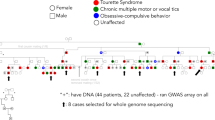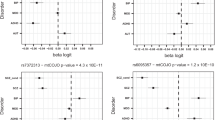Abstract
The dopamine transporter (DAT) is the site of action of stimulants, and variations in the human DAT gene (DAT1) have been associated with susceptibility to several psychiatric disorders including attention deficit hyperactivity disorder (ADHD) and bipolar disorder. We have previously reported the association of bipolar disorder to novel SNPs in the 3′ end of DAT1. We now report the identification of 20 additional SNPs in DAT1 for a total of 63 variants. We also report evidence for association to bipolar disorder in a second independent sample of families. Eight newly identified SNPs and 14 previously identified SNPs were analyzed in two independent samples of 50 and 70 families each using the transmission disequilibrium test. Two of the eight new SNPs, one in intron 8 and one in intron 13, were found to be moderately associated with bipolar disorder, each in one of the two independent samples. Analysis of haplotypes comprised of all 22 SNPs in sliding windows of five adjacent SNPs revealed an association to the region near introns 7 and 8 in both samples (empirical P-values 0.002 and 0.001, respectively, for the same window). The haplotype block structure observed in the gene in our previous study was confirmed in this sample with greater resolution allowing for discrimination of a third haplotype block in the middle of the gene. Together, these data are consistent with the presence of multiple variants in DAT1 that convey susceptibility to bipolar disorder.
This is a preview of subscription content, access via your institution
Access options
Subscribe to this journal
Receive 12 print issues and online access
$259.00 per year
only $21.58 per issue
Buy this article
- Purchase on Springer Link
- Instant access to full article PDF
Prices may be subject to local taxes which are calculated during checkout


Similar content being viewed by others
Accession codes
References
Cook Jr EH, Stein MA, Krasowski MD, Cox NJ, Olkon DM, Kieffer JE et al. Association of attention-deficit disorder and the dopamine transporter gene. Am J Hum Genet 1995; 56: 993–998.
Gill M, Daly G, Heron S, Hawi Z, Fitzgerald M . Confirmation of association between attention deficit hyperactivity disorder and a dopamine transporter polymorphism. Mol Psychiatry 1997; 2: 311–313.
Waldman ID, Rowe DC, Abramowitz A, Kozel ST, Mohr JH, Sherman SL et al. Association and linkage of the dopamine transporter gene and attention-deficit hyperactivity disorder in children: heterogeneity owing to diagnostic subtype and severity. Am J Hum Genet 1998; 63: 1767–1776.
Daly G, Hawi Z, Fitzgerald M, Gill M . Mapping susceptibility loci in attention deficit hyperactivity disorder: preferential transmission of parental alleles at DAT1, DBH and DRD5 to affected children. Mol Psychiatry 1999; 4: 192–196.
Kelsoe JR, Sadovnick AD, Kristbjarnarson H, Bergesch P, Mroczkowski-Parker Z, Drennan M et al. Possible locus for bipolar disorder near the dopamine transporter on chromosome 5. Am J Med Genet 1996; 67: 533–540.
Greenwood TA, Alexander M, Keck PE, McElroy S, Sadovnick AD, Remick RA et al. Evidence for linkage disequilibrium between the dopamine transporter and bipolar disorder. Am J Med Genet 2001; 105: 145–151.
Kelsoe JR, Spence MA, Loetscher E, Foguet M, Sadovnick AD, Remick RA et al. A genome survey indicates a possible susceptibility locus for bipolar disorder on chromosome 22. Proc Natl Acad Sci USA 2001; 98: 585–590.
Dick DM, Foroud T, Edenberg HJ, Miller M, Bowman E, Rau NL et al. Apparent replication of suggestive linkage on chromosome 16 in the NIMH genetics initiative bipolar pedigrees. Am J Med Genet 2002; 114: 407–412.
Kruglyak L, Daly MJ, Reeve-Daly MP, Lander ES . Parametric and nonparametric linkage analysis: a unified multipoint approach. Am J Hum Genet 1996; 58: 1347–1363.
Vandenbergh DJ, Thompson MD, Cook EH, Bendahhou E, Nguyen T, Krasowski MD et al. Human dopamine transporter gene: coding region conservation among normal, Tourette's disorder, alcohol dependence and attention-deficit hyperactivity disorder populations. Mol Psychiatry 2000; 5: 283–292.
Greenwood TA, Alexander M, Keck PE, McElroy S, Sadovnick AD, Remick RA et al. Segmental linkage disequilibrium within the dopamine transporter gene. Mol Psychiatry 2002; 7: 165–173.
Kokoris M, Dix K, Moynihan K, Mathis J, Erwin B, Grass P et al. High-throughput SNP genotyping with the Masscode system. Mol Diagn 2000; 5: 329–340.
Sham PC, Curtis D . An extended transmission/disequilibrium test (TDT) for multi-allele marker loci. Ann Hum Genet 1995; 59: 323–336.
Sham PC, Curtis D . Monte Carlo tests for associations between disease and alleles at highly polymorphic loci. Ann Hum Genet 1995; 59: 97–105.
Nyholt DR . A simple correction for multiple testing for single-nucleotide polymorphisms in linkage disequilibrium with each other. Am J Hum Genet 2004; 74: 765–769.
Lewontin RC . On measures of gametic disequilibrium. Genetics 1988; 120: 849–852.
Abecasis GR, Cookson WO . GOLD—graphical overview of linkage disequilibrium. Bioinformatics 2000; 16: 182–183.
Halperin E, Eskin E . Haplotype reconstruction from genotype data using Imperfect Phylogeny. Bioinformatics 2004; 20: 1842–1849.
Greenwood TA, Kelsoe JR . Promoter and intronic variants affect the transcriptional regulation of the human dopamine transporter gene. Genomics 2003; 82: 511–520.
Khodayari N, Garshasbi M, Fadai F, Rahimi A, Hafizi L, Ebrahimi A et al. Association of the dopamine transporter gene (DAT1) core promoter polymorphism −67T variant with schizophrenia. Am J Med Genet 2004; 129B: 10–12.
Curran S, Mill J, Tahir E, Kent L, Richards S, Gould A et al. Association study of a dopamine transporter polymorphism and attention deficit hyperactivity disorder in UK and Turkish samples. Mol Psychiatry 2001; 6: 425–428.
Heinz A, Goldman D, Jones DW, Palmour R, Hommer D, Gorey JG et al. Genotype influences in vivo dopamine transporter availability in human striatum. Neuropsychopharmacology 2000; 22: 133–139.
Jacobsen LK, Staley JK, Zoghbi SS, Seibyl JP, Kosten TR, Innis RB et al. Prediction of dopamine transporter binding availability by genotype: a preliminary report. Am J Psychiatry 2000; 157: 1700–1703.
Michelhaugh SK, Fiskerstrand C, Lovejoy E, Bannon MJ, Quinn JP . The dopamine transporter gene (SLC6A3) variable number of tandem repeats domain enhances transcription in dopamine neurons. J Neurochem 2001; 79: 1033–1038.
Fuke S, Suo S, Takahashi N, Koike H, Sasagawa N, Ishiura S . The VNTR polymorphism of the human dopamine transporter (DAT1) gene affects gene expression. Pharmacogenomics J 2001; 1: 152–156.
Mill J, Asherson P, Browes C, D’Souza U, Craig I . Expression of the dopamine transporter gene is regulated by the 3′ UTR VNTR: Evidence from brain and lymphocytes using quantitative RT-PCR. Am J Med Genet (Neuropsychiatric Genetics) 2002; 114: 975–979.
Miller GM, Madras BK . Polymorphisms in the 3′-untranslated region of human and monkey dopamine transporter genes affect reporter gene expression. Mol Psychiatry 2002; 7: 44–55.
Acknowledgements
We are grateful to the family members who participated in this study. This work was supported by grants to JRK from NIH (MH47612, MH59567, MH68503, DA13769), the Department of Veterans Affairs and by the UCSD General Clinical Research Center (M01 RR00827). JRK is a founder and holds equity in Psynomics Inc. We would like to thank A Dessa Sadovnick, Ronald Remick, Susan McElroy, and Paul Keck for contributing a portion of the samples analyzed. Data and biomaterials were collected in four projects that participated in the NIMH Bipolar Disorder Genetics Initiative. From 1991–1998, the Principal Investigators and Co-investigators were: Indiana University, Indianapolis, IN, UO1 MH46282, John Nurnberger, MD, PhD, Marvin Miller, MD, and Elizabeth Bowman, MD; Washington University, St Louis, MO, UO1 MH46280, Theodore Reich, MD, Allison Goate, PhD, and John Rice, PhD; Johns Hopkins University, Baltimore, MD UO1 MH46274, J Raymond DePaulo, Jr, MD, Sylvia Simpson, MD, MPH, and Cohn Stine, PhD; NIMH Intramural Research Program, Clinical Neurogenetics Branch, Bethesda, MD, Elliot Gershon, MD, Diane Kazuba, BA, and Elizabeth Maxwell, MSW.
Author information
Authors and Affiliations
Corresponding author
Rights and permissions
About this article
Cite this article
Greenwood, T., Schork, N., Eskin, E. et al. Identification of additional variants within the human dopamine transporter gene provides further evidence for an association with bipolar disorder in two independent samples. Mol Psychiatry 11, 125–133 (2006). https://doi.org/10.1038/sj.mp.4001764
Received:
Revised:
Accepted:
Published:
Issue Date:
DOI: https://doi.org/10.1038/sj.mp.4001764
Keywords
This article is cited by
-
Dopamine transporter silencing in the rat: systems-level alterations in striato-cerebellar and prefrontal-midbrain circuits
Molecular Psychiatry (2022)
-
Mice with reduced DAT levels recreate seasonal-induced switching between states in bipolar disorder
Neuropsychopharmacology (2018)
-
GBR 12909 administration as an animal model of bipolar mania: time course of behavioral, brain oxidative alterations and effect of mood stabilizing drugs
Metabolic Brain Disease (2015)
-
Reduced Dopamine Transporter Functioning Induces High-Reward Risk-Preference Consistent with Bipolar Disorder
Neuropsychopharmacology (2014)
-
Calcium signalling and psychiatric disease: bipolar disorder and schizophrenia
Cell and Tissue Research (2014)



